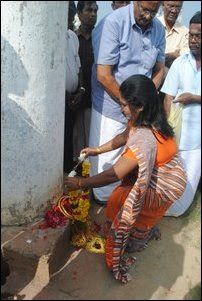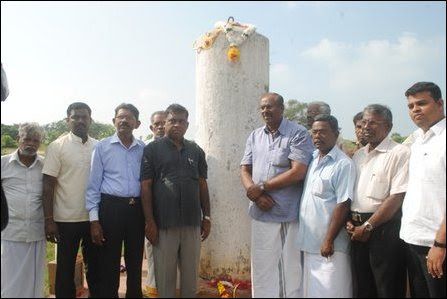
Publisher:
Bonnie King
CONTACT:
Newsroom@Salem-news.com
Advertising:
Adsales@Salem-news.com

~Truth~
~Justice~
~Peace~
TJP
Jan-12-2014 10:57

 TweetFollow @OregonNews
TweetFollow @OregonNews
40th Year of Massacre at World Tamil Research Conference Remembered
Intro by Visvanathan for Salem-News.com“the refusal of the government to appoint a Presidential Commission to inquire into the seven deaths and the conduct of the Police which led to those deaths, was a prime cause of the demand for a separate state.” - Appapillai Amirthalingam, the TULF parliamentarian
 Photos courtesy: TamilNet |
(MELBOURNE TamilNet) - Forty years ago a peaceful World Tamil Research Conference would have gone on peacefully between 3 to 9 January had not Sinhalese Police action resulted in the loss of nine lives, the loss of civilian property and more than 50 civilians sustaining severe injuries. The SLFP-dominated government of Sirimavo Bandaranaike had requested that the conference be held in the capital Colombo but the conference organizers held it in the Tamil-dominant city of Jaffna. That was the crime the Tamils committed for which they had to pay such a high price.
On January 10, the organizers decided to hold a public meeting to distribute awards to those who had participated in the cultural program. The audience, more than 10,000 in number, spanned the road and overflowed into open expanses. Assistant Superintendent of Police Chandrasekera, a Sinhalese commissioned officer, led a truckload of anti-riot police of more than 40 to the scene. Their unheralded arrival ended in the chaotic disruption of the ceremony.
The police had been advancing slowly through the crowd in jeep and truck wearing steel helmets, ordering the crowd to move. At the time Professor Naina Mohamed, a distinguished Tamil scholar from India, was speaking and the crowd was heavily packed, such that the police could not proceed any further. Then the policemen who were armed with rifles, tear-gas bombs, batons and wicker shields started attacking those who stood in their way. The result was a stampede to escape the police attack, as policemen fanned out in all directions assaulting all and sundry. Some even jumped into the moat beside the Fort to escape the attack.
The overhead electric wires were brought down by gun-shots. A policeman was seen throwing a tear-gas bomb which did not explode, and then firing at the electric wire, resulting in a burning coil falling on him. The foreign delegates who attended the conference had also confirmed that the Police had fired into the air. Seven civilians died of electrocution. Several others sustained severe injuries due to the police charging at them. The police officers involved were subsequently promoted instead of being reprimanded by the government or even severely punished.
Unlike now, at that time the Commission of Inquiries were genuine and fast. The report of the Commission of Inquiry on the Tragedy of January Tenth 1974 published on 18 February 1974 said,
- “The irresistible conclusion we come to is that the police on this night (10 January 1974) was guilty of a violent and quite an unnecessary attack on unarmed citizens.
- "We are gravely concerned that they lacked the judgment which we expected of policemen in a civilian police force whose duties call for tactful handling even in the most difficult situation.”
Appapillai Amirthalingam, the TULF parliamentarian stated:-
- “the refusal of the government to appoint a Presidential Commission to inquire into the seven deaths and the conduct of the Police which led to those deaths, was a prime cause of the demand for a separate state.”
This incident was the precursor to the revenge killing of the SLFP mayor of Jaffna, Alfred Duraiappah, a Sinhalese stooge, by the LTTE leader Prabhakaran himself, and this began the era of Tamil militancy among the youth leading up to the Sri Lankan civil war.
Another Sinhalese crime that triggered the ethnic conflict was an organized mob of Sinhalese thugs, led by UNP Sinhalese politicians, who went on a rampage on the nights of May 31 to June 1, 1981, burning the Jaffna Public library, which contained rare volumes of books and documents that was turned to ash overnight. It was one of the most violent examples of ethnic cleansing of the 20th century. This was the beginning of the cultural genocide of the Tamils.
On 10 January every year the Tamils the world remember this day. Please read this Tamil Net report this year on the 40th year of massacre at World Tamil Research Conference.
 [TamilNet, Saturday, 11 January 2014, 09:20 GMT]
[TamilNet, Saturday, 11 January 2014, 09:20 GMT]
Tamil politicians and activists in Jaffna on Wednesday observed the 40th year remembrance of the massacre carried out by the occupying Sri Lankan Police on the final day of the Fourth International Conference of Tamil Studies held in Jaffna in 1974. The massacre took place on 10th January, which was the final day of the conference.
The occupying Sri Lankan Police, under the command of the then Assistant Superindentet of Police in Jaffna, Chandrasekara, launched an attack on the masses when Prof Naina Mohammad from Tamil Nadu was delivering his public speech.
Nine civilians were killed when the SL Police opened fire. The victims included 3 students, a teacher and a native doctor.
The Sri Lankan State had been trying to block participants from abroad attending the conference held in Jaffna in 1974 by delaying visas and was working against the conference being organized in Jaffna.
The attitude shown by the Sinhala State towards the conference coupled with the massacre of civilians was one of the reasons for the rise of Tamil militancy. Urumpiraay P. Sivakumaran took a vow to take revenge on the ASP Mr Chandrasekara, but he escaped an assassination attempt.
Later, the ASP was ‘rewarded’ for his services by the Sinhala State and he reached the highest echelons of the police service.
Ilangkai Thamizh Arasuk Kadchi (ITAK) General Secretary Mavai Senathirajah, Northern Provincial Council (NPC) councillor Mr MK Sivajilingam of Tamil Eelam Liberation Organisation (TELO) and councillor Ananthi Sasitharan, were among the political activists, who took part at the memorial event on Friday at Muttave'li in Jaffna.
 |
 |
Please also read this Tamil Net report on Villagers surrounding SL military camp, to demand removal of soldiers harassing women in the village.
[TamilNet, Sunday, 12 January 2014, 10:41 GMT]
The people of Pi’laavaththai village in Vaddukkoaddai, on Saturday surrounded the mini-camp of the occupying Sri Lankan military and demanded immediate removal of the soldiers, who have been harassing the women in the village. The SL military has been sexually harassing the women and those who opposed to it were being threatened and assaulted. The villagers surrounded the camp after Sinhala soldiers were threatening the women by throwing stones at their houses. The SL military has been forced to admit that they would be withdrawing the soldiers, but has continued deployment of additional troops around the mini-camp, news sources in Vaddukkoaddai said.
The villagers surrounded the mini-camp and demanded the Sri Lankan Police at Vaddukkoaddai to arrest the culprits.
But, the SL police refused to act on the complaints and the villagers stepped up their protest against the SL military.
The villagers demanded complete and immediate withdrawal of the SL military from the camp.
As the confrontation continued, the SL military officers finally chose to argue that they would be withdrawing the soldiers, but they had to place other soldiers to guarantee the ‘security’ of the military base. The villagers argued that the SL policemen could stay there to ensure the concerns of the SL military until the camp is dismantled.
In the meantime, the SL military has beefed up its deployment around the camp.
The villagers blame that the Sinhala soldiers were sexually harassing the women in the village for a long time.
 |
 |
 |
Articles for January 11, 2014 | Articles for January 12, 2014 | Articles for January 13, 2014



googlec507860f6901db00.html


Terms of Service | Privacy Policy
All comments and messages are approved by people and self promotional links or unacceptable comments are denied.
[Return to Top]
©2025 Salem-News.com. All opinions expressed in this article are those of the author and do not necessarily reflect those of Salem-News.com.